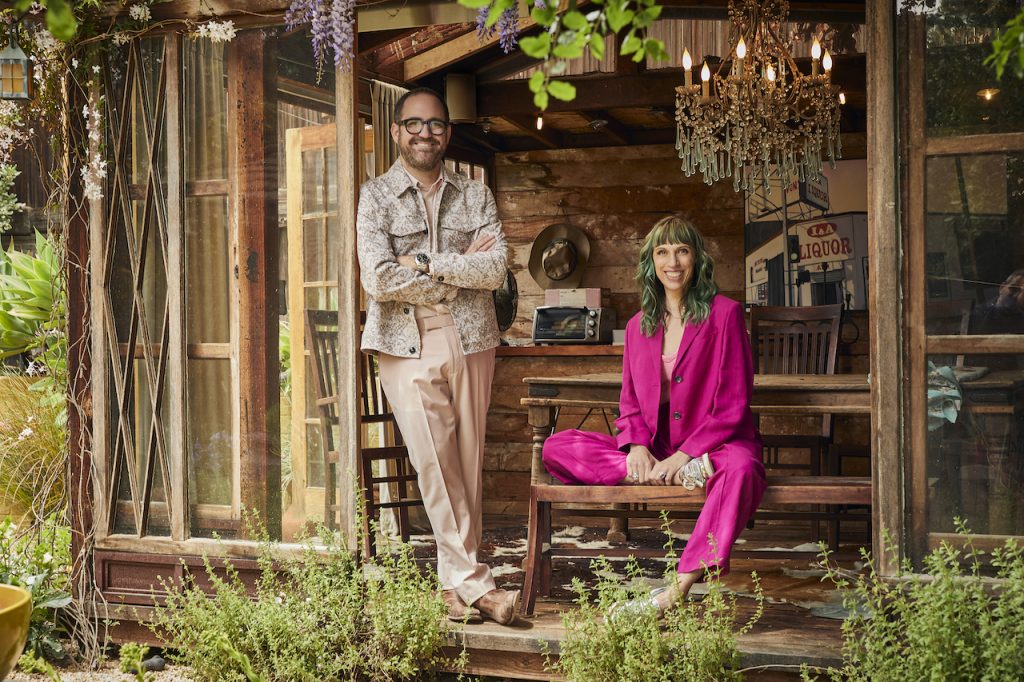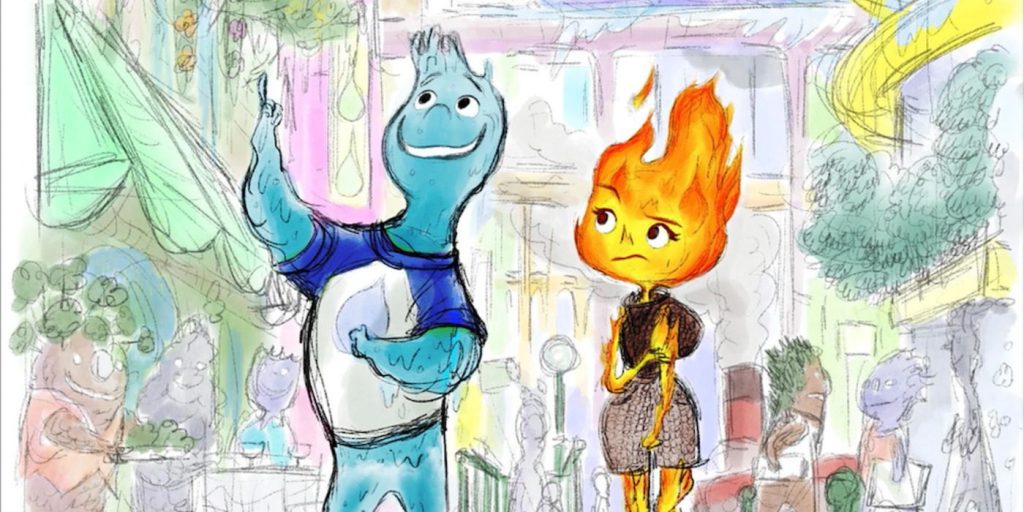The concept for a romance set in Element City began when first generation Korean-American director Paul Sohn (The Good Dinosaur, Luca) married his Italian-American wife and wanted to explore the cultural differences in their respective backgrounds in his film Elemental.
“Sohn started toying around with the idea of chemical elements being compatible and incompatible – a metaphor for his marriage,” says co-writer John Hoberg (Downward Dog, Black-ish). Allegedly, there were around nine iterations of Sohn’s idea pitting the rare earth elements against the metallic ones, until they decided to simplify and reduce the elements to earth, wind, fire, and water to tell the story.
Brenda Hseuh (How I Met Your Mother) wrote the earliest two drafts of Elemental and John Hoberg and Kat Likkel write several drafts over three years. All three writers initially collaborated to construct the world and the main characters.
Pixar’s connection to Hoberg and Likkel comes from Dan Fogelman who wrote Cars and they also wrote on Fogelman’s TV show The Neighbors. “Pixar is oddly like MI5. They come and find you. And suddenly we got a phone call from our agent saying, ‘I just got a call from someone from Pixar who wants to meet you,’” comments Lykkel.
A Character Approach To Storytelling
The high-concept cleverness of Elemental can easily overshadow its underlying themes of class, exclusion, immigration, and traditions into animated gimmickry. In order to counter this outcome, John Hoberg and Kat Likkel approach the story from a character point of view. “A lot of people will try to find the plot or they’ll dive into the machinations what are the things that happen,” continues Hoberg.
Pixar looks for characters that have internal issues, who have their own obstacles within them to their own goals, and put them through the ordeal they need to go through to learn.
When Peter, Kat, and John first discussed what Elemental might be, “we talked a lot about our life experiences and the type of writing we like. Pixar really respond to how a character responds in a situation rather than how to create a situation to put the character in a lot of places,” says Hoberg.
Kat Likkel notes the similarity in writing Pixar movies to their television writing background in that breaking the story is a highly-collaborative process like a writers’ room. “It’s not like writing a normal feature where you meet with some executives, you have the idea that’s approved, and then you go away by yourself to write it.”

Kat Likkel & John Hoberg. Photo by Jsqured Inc
The Elemental writers’ room comprised Peter Sohn at the helm, his producer, Kat Likkel, John Hoberg, and story artists who would sketch while you’re pitching. The collaboration expanded as the story artists contributed their life experiences to the process. Needless to say, many ideas didn’t make the final script and there was a lot of rewriting along the way.
Kat Likkel compared this “live writing” to multi-cam television writing where you’re rewriting in front of an audience on set. When things go wrong, you have to come up with an idea really fast and communicate it quickly. The story artists would come up with a quick drawing which is finessed into something everyone was happy with. The artists would also convey the technological animation constraints of shaping the story.
The ongoing consultation process between these disciplines helps to smooth out many creative differences. “One of the things that we discovered is, we would turn in a scene (or sequence) and the director will hand it off to a particular story artist. And then you’ll talk through with the story artist what this scene is. We’ll read it out loud to get the emotional gist of it. And then they have the freedom to go off and do what they want to do with it,” says Likkel.
“We’re using words and some action lines to describe visuals and dialogue and it quickly started to become a nice back and forth, sometimes to create things we didn’t think of,” adds Hoberg. Likkel and Hoberg were given early versions of the animations throughout the process.
“So, for Peter Sohn, it wasn’t just the challenge of trying to write a great story. It was also creating a whole new process in animation to do animate fire and water at the same time,” says Hoberg.
Can Fire and Water Mix?
The early iterations of Elemental featured a periodic table of chemical elements. “One of the early drawings was an apartment building that was the periodic table of elements,” recalls Hoberg. “At some point, it moved to the Greek elements of fire, water, wind, and earth as the team got more into the characters and Sohn was starting to sense a smaller set of groups that would share the same traits. I think that spoke to his origin story in a lot of ways.”
“I think everything with Pixar starts out with an enormous idea and through the course of production, all the discussions and all the different iterations, it all comes down to its simplest core,” Hoberg muses.
The crux of Elemental is whether Ember (voiced by Leah Lewis and represents Fire) and Wade (voiced Mamoudou Athie and represents Water) can truly be together. Can opposites attract? Ember is hot-headed, angry, and blustery, and Wade goes with the flow and is more even-tempered. Their signs define their personalities.

Early concept art of Wade and Ember in Elemental.
“When you first meet Wade, he’s always going with whatever is happening. Even when he gets into the water pipe, he’s washed and he’s stuck in there. He comes splurting out and he runs away,” says Likkel. Water is the core of Wade’s character. “And through the course of this, there’s a moment where there’s the water’s bursting through the sandbags, he stands up and he actually walks against water for the first time. He puts his arm out and he gets huge. That’s his first move of going against the flow in a way. It’s because of Ember’s influence,” Likkel elaborates. “When he shows up and says that he loves her, that is a complete moment of going against what would be the easy, fluid way of his life.”
“Ember has that slightly dangerous, fiery temper. But what she ends up learning through Wade is that she starts to discover that vulnerability when the firewall isn’t up is where she really lives. And so, they both go on this journey to go against their natural element, to find who they are in a lot of ways. And the other one helps them get there.”
The Immigration Experience
Elemental covers a lot of rich thematic terrain that extends from being an immigrant. Elemental City is reminiscent of Ellis Island, America – the land of opportunity where the best of the best and the worst of the worst happens. It’s also about honoring the traditions of the old country of Fireland in a new land that doesn’t always want the best for them.
Bernie (Ember’s father voiced by Ronnie Del Carmen) assumes Ember will take over the family business after his retirement and wants her to maintain the traditions of their ancestral homeland of Fireland.
“One of the things we were trying to show in Elemental City is that it wasn’t ill will to push the fire people off to the side, but it was really thoughtlessness. And its inhabitants weren’t actively trying to exclude anyone. It was a society going on with the way it was and inadvertently leaving some people to fend for themselves,” says Hoberg.
“Some of the worst things that happen in immigration situations are just a lack of thinking about someone else’s experience,” adds Likkel. After all, Ember’s family were trying to build a fire store in a place that didn’t value fire.
“I think it happens in real society. It’s that blindness when it’s not your culture and your people, and you think immigrants should all just be like you, or you just don’t connect, or even realize, that there are real differences. It’s just a lack of people coming together because I think we have so much more alike when it comes all down to it,” asserts Likkel.
There are even hints of snobbery and exclusion when Ember meet’s Wade’s family. “Wade’s family is very welcoming, but their life is very different because they’re established in Elemental City. Even Wade’s mother, who has the best ability, is accidentally saying some things that are slightly inappropriate towards Ember. And, Wade’s got the foot and mouth uncle as well, who says some pretty offensive stuff,” adds Hoberg.
Bernie (Ember’s dad voiced by Ronnie Del Carmen) and Cinder (Ember’s mom voiced by Shill Ommi) want Ember to carry on the family traditions, heritage, and lineage. But they also want her to be happy and follow her own path.
Ember and Wade each have their own cultures, so there will invariably be a culture clash. “Elemental speaks to any relationship, friendships, marriage, family coming together and ultimately giving way to each other on little things and then finding those places that you’re similar. They’re from different cultures, not different races,” declares Likkel.
These differences ultimately require acceptance and balance. “Ember and Wade are at the extremes of their personalities when we first meet them. Ember’s fiery and ready to combust at a moment’s notice. And Wade is so ‘go with the flow’ that he almost doesn’t ever think about what he really wants,” says Likkel.
“Eventually Ember and Wade come together to bring out the best of who they are. I just think that’s a great story about relationships. I think it’s a great story for people in general. I think it’s a great story for society. I think it’s such a relatable story. We can still be who we are, but complement those people around us,” says Hoberg.
Hoberg cites a significant scene when Wade argues with Ember. “It’s her of way of knowing that this is something that’s missing in her and it’s frustrating to her. That he’s got it. But she sees in him, I think you admire the things that you don’t have,” says Hoberg. She needs to let her guard down. Then Wade has a moment, “It’s funny. I thought you were so strong, but it turns out you’re just afraid.”
“I think that’s his way of saying he admires her strength and that she was not going with the flow. She’s making things happen everywhere. And he is not a guy who makes things happen. He’s not even in a job he likes.”
Combining fire and water is a physical impossibility. So is mixing oil and water. When Wade and Ember first touch they change each other’s fundamental chemistry and they become part of a couple as well as remain individuals.”You’re different than me. We come from very different places, very different backgrounds, but there is something in us that is the same, and we can connect. And when the chemistry changes in both, the bond is hard to break apart. You’ve created a third thing. You’ve created something new,” concludes Mikkel.
